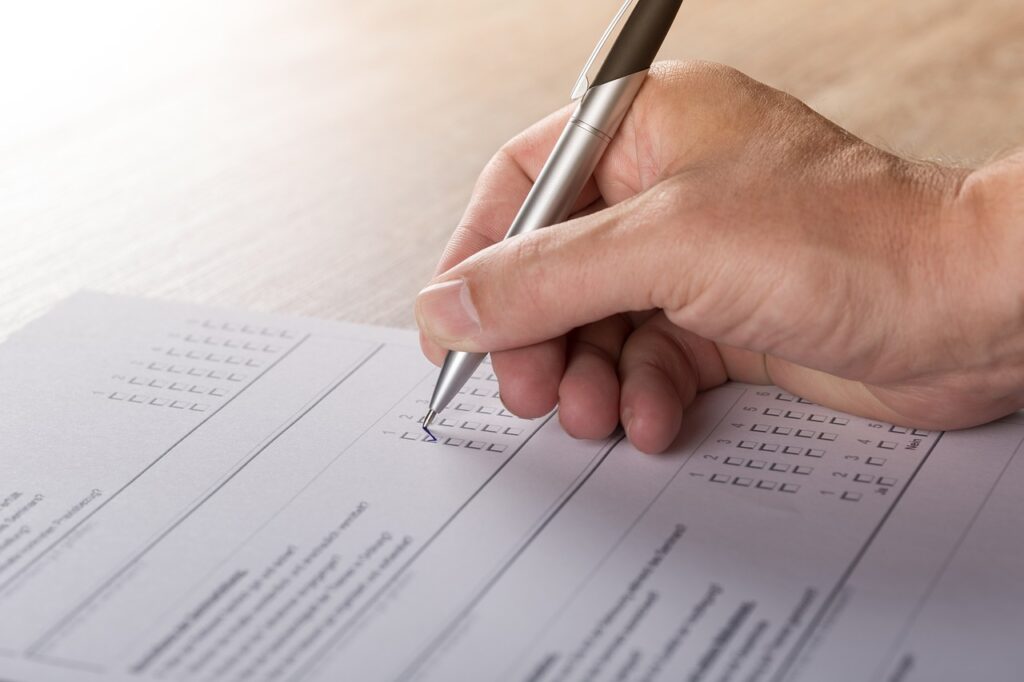
Do you ever wonder how much weight you should give to public opinion polls? For instance, if a politician has a low job approval rating, does that prove the politician is doing a bad job? Or what about when you’re responding to a survey on specific issues, such as the economy, inflation, or the U.S.- Mexico border? If you aren’t happy with current conditions on these matters, does it mean you should give the president or party in charge a low approval rating?
Most of us know that public opinion is influenced by party identification. The question is, how much? Does being a Republican or a Democrat almost entirely drive our perspectives? Or do we shape our views through independent critical thinking, with party ID being only one of many factors we consider? Let’s answer these questions.
At first blush, it’s apparent that party ID strongly drives responses to opinion polls.
We’ll start with views regarding the economy, over time, on the basis of Republican or Democrat party identification. Take a look at this graphic from an Economist/YouGov poll:

When we track Republican views, we see 50 to 80% of Republicans agreeing that the economy was getting better during the time Trump was president. Positive sentiment dropped with the Covid-19 pandemic, but ratings returned to 65% by the time of the 2020 election. Then, in the three years since the inauguration of Joe Biden, 10% or less of Republicans saw the economy as getting better. Conversely, during the time Trump was president only 5 to 15% of Democrats felt the economy was getting better. But after Biden came into office, some 55% of Democrats saw improvement in the economy.
The economy didn’t fundamentally change between November of 2020 and January of 2021. Rather, Republican and Democrat perceptions of the economy changed in connection with the defeat of Trump and the election of Biden.
On the other hand, Democrat sentiment regarding the economy did decline in late 2021 and 2022, when inflation reached record levels. Democrats recognized that inflation was hurting the economy. Similarly, Republican sentiment regarding the economy dropped in connection with the onset of the Covid-19 pandemic and the ensuing recession. These results tell us that party ID isn’t the sole determinant of opinion regarding the economy.
More recent polls on Biden’s handling of the economy and inflation demonstrate that party ID heavily drives opinion.
Below I display a table from a recent CBS News Poll (YouGov), on Biden’s handling of the economy. Overall, 61% disapprove, while 39% approve. Among Democrats, 76% approve, while 24% disapprove. Republicans see the opposite—88% of Republicans disapprove, while only 12% approve. And Independents are in between—30% approve, while 70% disapprove.
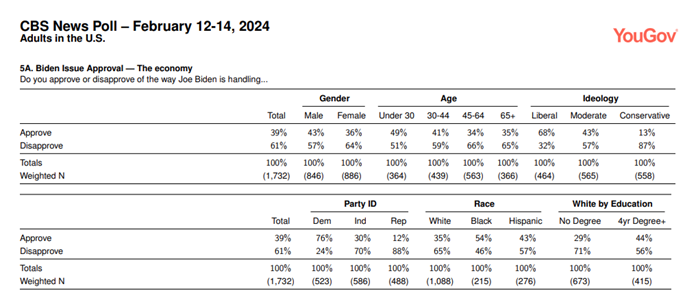
The table also reveals there some differences in perception on the basis of gender, age, race, and education. But these differences are relatively modest when compared with the stark differences based on party identification.
A similar breakdown in numbers occurs when we consider Biden’s handling of inflation.
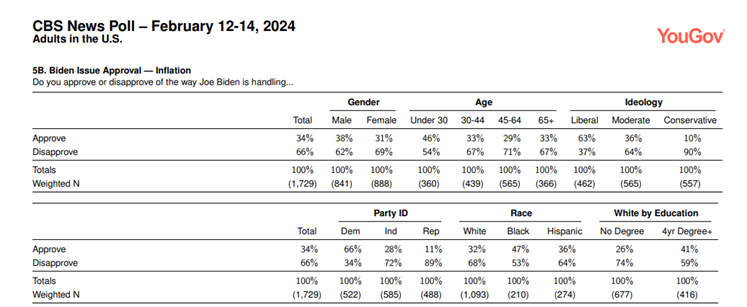
Overall, 34% of respondents approve, while 66% disapprove. As to Democrats, 66% approve, while 34% disapprove. For Republicans, only 11% approve, while 89% disapprove. For independents, 28% approve, while 72% disapprove.
Again, there are modest differences based on the factors of gender, age, race, and education. But party identification is clearly the factor that drives perception about Biden’s handling of inflation.
Even though the public recognizes that numerous factors are to blame for inflation, party ID heavily influences opinion regarding overall blame.
A January 2024 YouGov Survey on Inflation and Grocery Policy asked respondents to assess the extent to which 11 factors were to blame for inflation. Below I display the overall responses.
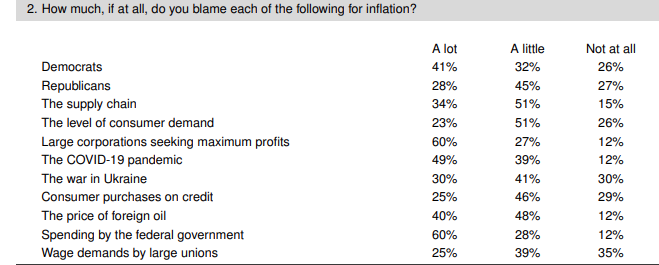
Interestingly, the respondents agreed that several factors were “A lot” or “A little” to blame for inflation. 73% thought Democrats were a lot or a little to blame, while 73% thought Republicans were a lot or a little to blame. 85% blamed the supply chain, 87% blamed large corporations seeking maximum profits, 88% blamed the pandemic, 88% blamed federal spending, and 88% blamed the price of foreign oil.
On the other hand, when we break down the above responses in terms of party identification (see pages 6-16 of the survey results) we see the responses were only sometimes influenced by this factor.
- 95% of Republicans saw Democrats as a lot or a little to blame for inflation; but only 50% of Democrats saw themselves as a lot or little to blame.
- 87% of Democrats saw Republicans as a lot or little to blame for inflation; but only 57% of Republicans saw themselves as a lot or little to blame.
- Both parties put approximately the same blame (85-90%) on the supply chain.
- Both parties put approximately the same blame (86-90%) on the pandemic.
- Both parties put approximately the same blame (88-95%) on the price of foreign oil.
- 91% of Democrats blamed large corporations seeking maximum profits, while 84% of Republicans blamed the corporations.
These results are intriguing because they tell us that respondents understand that high inflation was caused by numerous factors. Intellectually, they understand that the supply chain, the pandemic, corporate greed, and the price of foreign oil were all partly to blame. Yet, in the next breath, 95% of Republicans blame Democrats a lot or a little, while 85% of Democrats blame Republicans a lot or a little. And, on Biden’s handling of inflation, 89% of Republicans disapprove, while 66% of Democrats approve.
When looking at public opinion regarding how Biden and the Republicans in Congress are handling the situation at the U.S.-Mexico border, party ID continues to drive views.
Below I display two tables from a recent CBS News YouGov poll that asked respondents to assess job approval for Joe Biden and the Republicans in Congress regarding how they are handling matters concerning the U.S.-Mexico border.
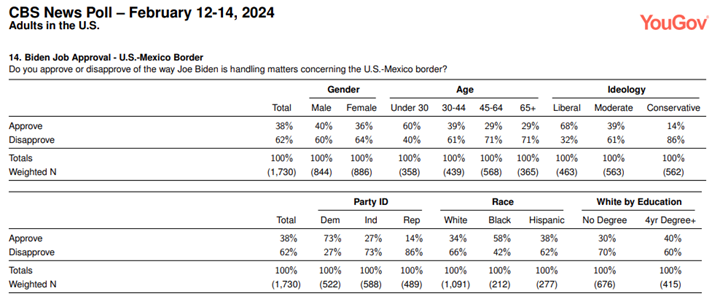
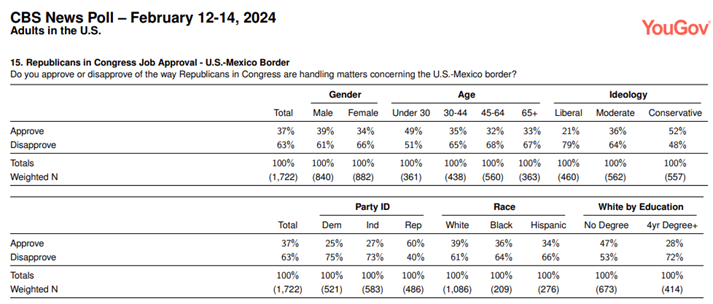
In terms of Joe Biden and total respondents, only 38% approve, while 63% disapprove. Yet almost three-fourths (73%) of Democrats approve, while 86% of Republicans disapprove. The numbers for independents were in between, with 27% approving and 73% disapproving.
In terms of the Republicans in Congress and total respondents, only 37% approve, while 63% disapprove. Disapproval rates among Democrats and independents were 75% and 73%, respectively, while only 40% of Republicans disapprove.
These results are interesting because if displayed in tandem they point to certain conclusions. Yet if displayed in isolation they point to different conclusions. When shown in tandem we see that respondents (total) are disapproving of both Joe Biden (62%) and the Republicans in Congress (63%). Yet if we only saw the job approval numbers for Joe Biden, it would be easy to conclude he is doing a bad job, especially since 73% of independents are disapproving. On the other hand, were we just to see the numbers for the Republicans in Congress, it would be easy to conclude they are doing a bad job, especially since 73% of independents are disapproving.
Given that Republicans and Democrats use and trust entirely different media sources, it’s not surprising that their respective views are consonant with their information bubbles.
When it comes to trusted media sources, Republicans rely heavily on such outlets as Fox News, Parler, and Truth Social. Democrats and independents trust and use a wider variety of sources. However, they distrust and tend not to use Fox News, Parler, and Truth Social. In America, we are differentially informed and indoctrinated when it comes to politics and the news. Every day our more partisan media outlets hammer away at recent polling data and tell us what to think. It shouldn’t be surprising that our responses to public opinion polls reflect the content and bias of our respective information bubbles.
Takeaway: Americans need to be cautious in interpreting and taking opinion polls because party ID is so often a dominant factor in responses.
In looking at responses to public opinion polls, it’s clear that there are often significant differences based on political party ID. Time and again, our opinions on various matters are colored by this factor. While we may intellectually understand that most problems can be blamed on multiple causes, we nonetheless tend to solely blame or credit individual politicians on the basis of party ID.
While party ID drives our responses to polls, it is also a major factor when it comes to interpreting or assigning weight to their results. We look at polling results and interpret them in a way that confirms our political beliefs and party identification. And, if we’re trying to influence others, we may omit conflicting numbers and emphasize results that bolster the position of our party.
The way forward: Americans need to use their critical thinking skills in both interpreting and taking public opinion polls.
The next time you respond to a public opinion poll, be mindful of how your responses may be influenced by your party ID. Your ability to do this depends on some hard work beforehand. Stop listening exclusively to your party’s leaders and your chosen media outlets. Audit your information bubble to expand viewpoints and reduce bias. When asked to assess blame, think about the various factors that caused the problem and whether one person is solely or primarily accountable. When it comes to assessing performance, consider the degree of control the person has to solve the problem. Ask yourself what your party has done to contribute to a solution or find a middle ground compromise.
And the next time you have the results of a public opinion poll in your hands, don’t immediately look for the numbers that affirm your party’s position. And don’t immediately look for ways to discount or undermine results that you may not have wanted to see. Don’t cherry-pick the results with the intention of misleading or deceiving others. Instead, use your critical thinking skills to decide how much weight you personally want to give the results. How might you use the results to engage someone else in better understanding the causes of a problem and how it can be solved?
As more Americans develop and use their critical thinking skills, we will understand that matters such as the economy, inflation, and the situation at the southern border are complex and multi-faceted. Assigning primary blame to a president or a political party is a rubric designed to win elections, not solve problems. Solving problems depends on having a thorough understanding of what is causing them, along with cooperative efforts to develop solutions. America’s best interests are served by turning away from public opinion polling that reinforces partisan differences and obsesses over winning elections. Instead, we need to reinvent polling to serve the overriding interest in understanding and solving the country’s problems.
Leave a Reply